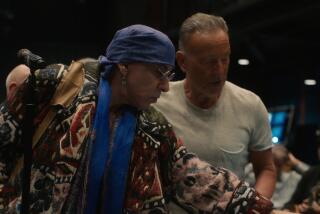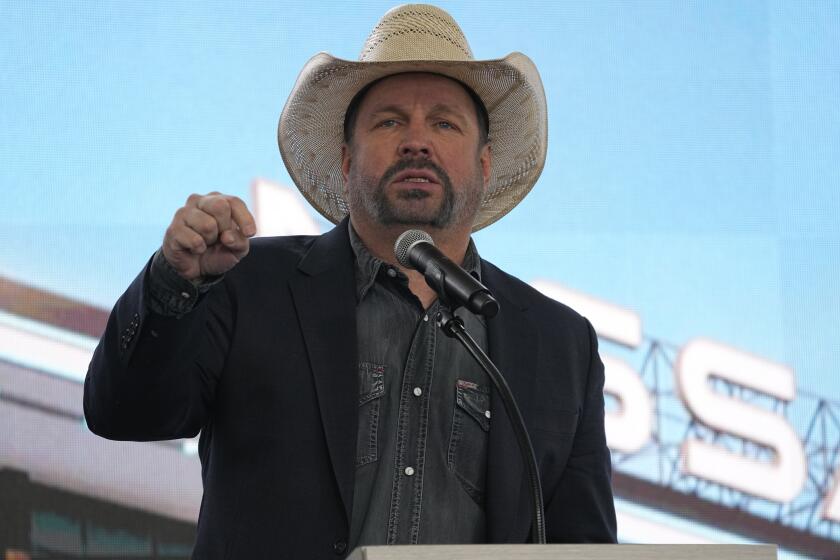Now, Thatâs the Way Elvis Really Was
This monthâs Elvis Presley festival on the Turner Classic Movies cable channel has been a painful reminder of all the years that rockâs greatest star wasted as an actor in Hollywood.
Whether playing a water-ski instructor wooing beautiful women in 1962âs âClambakeâ or a trapeze artist romancing them in 1963âs âFun in Acapulco,â Elvis sang some of the most pedestrian songs ever to reach the screen.
Anyone experiencing Presley for the first time this way must wonder why generations around the world--including musicians ranging from John Lennon to Bono--could have fallen under the spell of this guy.
The same festival gives us an answer Monday.
In the concert documentary âElvis: Thatâs the Way It Is,â we get to see the superb musical instincts and raw charisma of the man who, more than any other single figure, defined rock ânâ roll in the â50s.
Directed by Denis Sanders, the film chronicles one of Presleyâs early, triumphant Las Vegas showroom appearances--and it was widely cheered by Presley fans when first released in 1970.
The version TCM premieres Monday, however, is a vastly reworked and improved film, with more than half an hour of new concert or rehearsal footage that focuses more on Presleyâs creative process than his celebrity. The new approach was spearheaded by a team featuring producer Rick Schmidlin, editor Michael Salomon and rerecording mixer Bruce Botnick.
Unlike the actor we find sleepwalking through the formula movies, Elvis comes alive in front of the camera in the documentary, whether horsing around with his musicians during rehearsal or losing himself on stage in the music.
He was a man liberated.
Almost as soon as âHeartbreak Hotelâ established Presley as a superstar in 1956, he was Hollywood-bound.
Rock ânâ roll was viewed in the â50s as a passing fad, and Presleyâs manager, Col. Tom Parker, wanted to get Presley onto the screen before the fan base eroded.
Elvis made a few appealing films, but any hopes he had of being a serious actor were sabotaged by Parker, who was more interested in long-term, big-money guarantees than creative control of the films.
Soon, the promise of such films as âLoving Youâ and âJailhouse Rockâ gave way to endless tales of pretty women and flashy locales. Presley complained in private, but he continued to make the movies--33 in all over 16 years.
*
By 1969, he was desperate for the excitement and creative outlet that live shows offered.
He headed for Las Vegas for a four-week engagement at the International Hotel (now the Las Vegas Hilton). He not only received rave reviews but also set box-office records that even Frank Sinatra couldnât match.
After a second spectacular engagement at the International in January 1970, Parker signed with MGM to do a documentary film of Presleyâs third International stint that summer. In retrospect, the documentary might have been stronger if Sanders had shot it during the second engagement.
Driven by the challenge of returning to live shows after a decade away, Presley was thoroughly focused in the first two engagements. By the summer, the challenge was gone, and Presley began emphasizing showmanship more than music.
Still, the key moments of the film are thrilling. He seems like a man uncaged, making music with the sense of adventure and joy that marked his classic, pre-âHeartbreak Hotelâ recordings for the Sun label.
Presley didnât write songs, which separated him from almost every major rock figure of worth after Bob Dylan. But he was a pop auteur who wove his country, R&B; and gospel influences into musical productions that had a consistent and commanding vision.
The rehearsal footage is especially revealing in âThatâs the Way It Is,â showing Presley acting as his own musical director. Leading the band through the numbers, he instinctively gives the musicians guidelines by waving his arms or acting out drum or guitar parts.
Presley was too good a showman not to do the oldies in Las Vegas, but he mostly toyed with the songs and the audience during them. He spent considerable time making fun of his superstar image, kissing women at ringside and horsing around with band members.
But he brought together the showmanship and artistry spectacularly in key numbers, including his reworking of the Righteous Brothersâ hit âYouâve Lost That Lovinâ Feelinâ â and his own hit interpretation of Mark Jamesâ âSuspicious Minds.â
But maybe the telling moment in the film comes during rehearsals. While singing âLittle Sister,â a snappy 1961 hit, Elvis leads the band into the Beatlesâ âGet Back,â a song that relied on â50s R&B-rock; energy.
Presley sang âGet Backâ with absolute authority, neither intimidated by the Beatlesâ success nor puzzled by the abstract lyrics. Similarly, he connected in concert with the gospel undercurrents of Paul Simonâs âBridge Over Troubled Waterâ with the same command he would show in the driving swamp-rock of Tony Joe Whiteâs âPolk Salad Annie.â
Tragically, this renewed musical vitality wouldnât last. Soon he would become as complacent on the concert trail as he was before the movie camera. But for a brief spell in the late â60s and early â70s, Presley regained the magic that inspired a cultural revolution in the â50s. In this film, we see a piece of that magic.
*
* âElvis: Thatâs the Way It Is--Special Editionâ shows at 5 and 9 p.m. Monday on TCM. It will be released on video Tuesday.
More to Read
The biggest entertainment stories
Get our big stories about Hollywood, film, television, music, arts, culture and more right in your inbox as soon as they publish.
You may occasionally receive promotional content from the Los Angeles Times.










